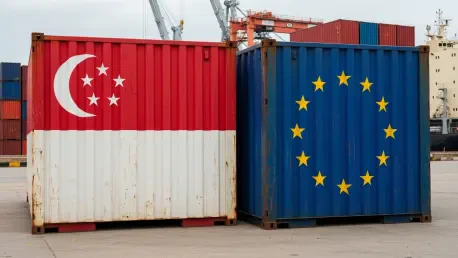What does it take for small businesses from a tiny Southeast Asian nation to make a big splash in one of the world’s most competitive trade regions? Singaporean small and medium-sized enterprises (SMEs) are doing just that, with an astonishing 86% reporting increased trade volumes in Europe, demonstrating their strategic prowess and adaptability in a market known for high standards and fierce competition. This isn’t just a fleeting trend—it’s a powerful story of ambition, innovation, and resilience that demands closer attention.
The significance of this success extends beyond individual companies. It underscores the strength of Singapore as a global trade hub and highlights the growing importance of the Asia-Pacific (APAC) to Europe trade corridor. With 66% of these SMEs boasting a substantial European customer base—well above the regional average of 50%—their achievements signal opportunities for other APAC businesses to follow suit. This narrative isn’t just about numbers; it’s about how smaller players can redefine their place on the global stage through grit and smart planning.
Why Singaporean SMEs Are Standing Out in Europe
Singaporean SMEs have carved a notable niche in European markets, outpacing many of their regional peers. Data shows that 84% of these businesses report an improved outlook over the past year, a figure that stands 10% higher than the APAC average. This optimism isn’t unfounded—it’s built on a foundation of rising trade volumes and a growing customer base across the continent, positioning them as unexpected but formidable contenders.
Their success isn’t accidental but stems from a clear focus on key markets. The United Kingdom, Germany, and France emerge as primary destinations, with 81%, 70%, and 68% of Singaporean SMEs exporting to these countries, respectively. The UK, in particular, serves as the gateway for 36% of these businesses, reflecting deep-rooted trade ties that facilitate entry into the broader European landscape.
Beyond the big players, these SMEs are also making inroads into smaller markets like Italy, Spain, and Poland. This versatility showcases their ability to adapt to diverse consumer needs and navigate varying economic environments. Such widespread penetration highlights a strategic mindset that prioritizes both depth and breadth in market expansion.
The Strategic Importance of Singapore-Europe Trade
The trade relationship between Singapore and Europe holds immense value for both regions. As a pivotal hub in APAC, Singapore facilitates a crucial link for businesses seeking to tap into Europe’s demand for high-quality, innovative offerings. This connection is vital not only for the SMEs themselves but also for setting a benchmark for other regional players looking to expand internationally.
Europe’s evolving consumer trends and shifting supply chain dynamics present unique opportunities. Singaporean SMEs are at the forefront of capitalizing on these changes, contributing significantly to bilateral trade flows. Their ability to meet stringent European standards while maintaining competitive pricing positions them as key partners in this dynamic economic corridor.
This relationship also serves as a learning ground for broader APAC markets. The achievements of Singaporean businesses offer actionable insights into how smaller enterprises can overcome barriers to entry and thrive in complex international arenas. Their journey underscores the potential for mutual growth when strategic trade ties are nurtured effectively.
What Fuels Their Success Across the Atlantic
Several critical factors drive the impressive performance of Singaporean SMEs in Europe. Strong market penetration stands out, with a significant presence in major economies and a growing footprint in niche markets. This targeted approach ensures they reach diverse customer segments, enhancing their overall impact.
Demand plays a pivotal role, with 51% of these businesses citing increased European interest as a primary growth driver. Additionally, 41% have customized their products to align with local preferences, demonstrating a keen understanding of cultural nuances. Meanwhile, 43% have invested heavily in marketing and relationship-building, a move that sets them apart from many regional counterparts.
Their forward-thinking mindset is evident in an optimistic outlook, as 84% express confidence in sustained growth. This positivity, coupled with strategic investments and adaptability, equips them to tackle the competitive European landscape. It’s a blend of calculated risk-taking and consumer-focused innovation that keeps them ahead of the curve.
Challenges and Realities on the Ground
Despite the rosy picture, the path to success in Europe is fraught with obstacles. A staggering 85% of Singaporean SMEs identify global logistics disruptions as a persistent challenge, often compounded by high costs and complex customs regulations. These hurdles test their operational resilience daily, demanding creative solutions to maintain momentum.
One business owner captured the duality of opportunity and struggle, noting, “Europe holds incredible potential, but the maze of logistics expenses and regulatory requirements can be daunting.” This sentiment resonates widely, as many grapple with import taxes and supply chain intricacies while striving to scale their operations in unfamiliar terrain.
Yet, adaptability remains a hallmark of their approach. A notable 51% are prioritizing sustainability in their supply chain decisions, aligning with European values on environmental responsibility. This shift not only addresses market expectations but also positions them as progressive players in a region that increasingly values green practices.
Charting the Path Forward for Lasting Growth
To sustain and expand their European presence, Singaporean SMEs must adopt actionable strategies tailored to current challenges. Cost efficiency tops the list, with 40% pinpointing it as a critical concern. Partnering with logistics providers offering competitive rates—where 42% seek affordable shipping solutions—can make a significant difference in maintaining profitability.
Navigating regulatory landscapes is another priority, as 33% emphasize the need for customs clearance support and 27% seek guidance on compliance. Leveraging expert resources to demystify these complexities can streamline operations. Additionally, investing in market intelligence through research or trade consultants will help bridge gaps in local consumer understanding, ensuring more targeted offerings.
Embracing sustainability offers a competitive edge, building on the 51% already focusing on eco-friendly practices. Adopting green logistics and packaging solutions can further align with European standards, appealing to environmentally conscious consumers. These steps, rooted in real needs, pave the way for turning persistent challenges into opportunities for long-term success.
Looking back, the journey of Singaporean SMEs in European markets stands as a testament to their unwavering determination. Their ability to outperform regional averages while navigating logistical and regulatory storms reflects a rare blend of agility and foresight. The focus on sustainability and strategic market entry has already begun reshaping their global footprint. Moving ahead, the emphasis needs to shift toward forging stronger partnerships, refining cost structures, and deepening cultural insights. By doing so, these businesses can ensure that their hard-earned foothold in Europe transforms into a lasting legacy of innovation and growth.









